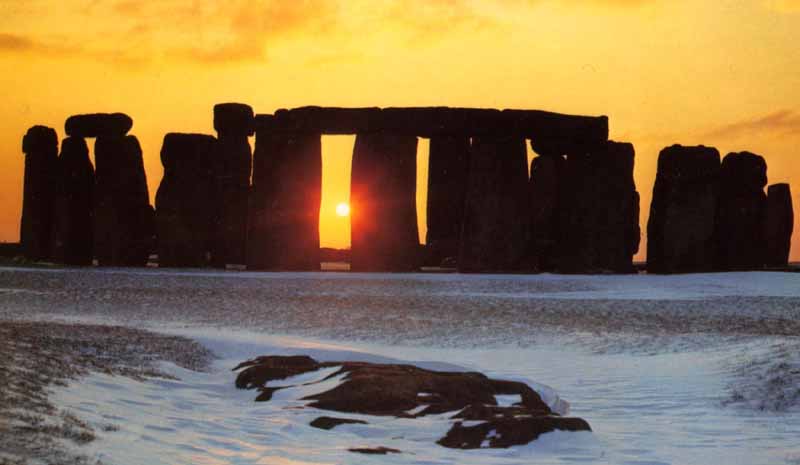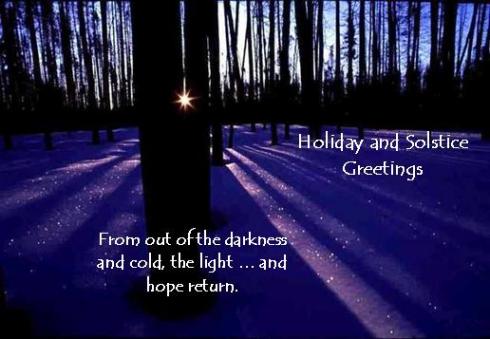Astronomical Observatories Around the World
England
Stonehenge Winter Solstice
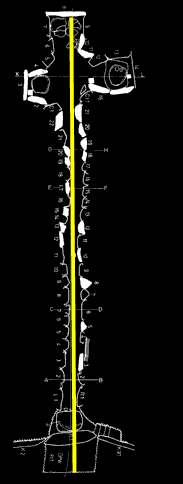
Once a year, at the winter solstice, the rising sun shines directly
along the long passage into the chamber for about 17 minutes and
illuminates the chamber floor. The sun enters the passage through a
specially contrived opening, known as a roofbox, directly above the main
entrance. Although solar alignments are not uncommon among passage
graves, Newgrange is one of few to contain the additional roofbox
feature The alignment is such that although the roofbox is above the
passage entrance, the light hits the floor of the inner chamber.
Today the first light enters about four minutes after sunrise, but
calculations based on the precession of the Earth show that 5000 years ago first light would have entered exactly at sunrise.
The solar alignment at Newgrange is very precise compared to similar phenomena at other passage graves such as Dowth or Maes Howe in the Orkney islands, off the coast of Scotland.
Current-day visitors to Newgrange are treated to a re-enactment of this
event through the use of electric lights situated within the tomb. The
finale of a Newgrange tour results in every tour member standing inside
the tomb where the tour guide then turns off the lights, and lights the
light bulb simulating the sun as it would appear on the winter solstice.
Anyone visiting the historic site can experience an approximation of
the phenomenon any time of year, and is often the highlight of the tour.
A lottery is held annually for "tickets" to be allowed into the tomb to
view the actual event. The popularity of this event was the reason a
lottery was introduced, and also why the lights were installed.
At dawn on Winter Solstice every year, just after 9:00 am, the sun
begins to rise across the Boyne Valley from Newgrange over a hill known
locally as Red Mountain. Given the right weather conditions, the event
is spectacular. At four and a half minutes past nine, the light from the
rising sun strikes the front of Newgrange, and enters into the passage
through the roofbox which was specially designed to capture the rays of
the sun. For the following fourteen minutes, the beam of light stretches
into the passage of Newgrange and on into the central chamber, where,
in Neolithic times, it illuminated the rear stone of the central recess
of the chamber. With simple stone technology, these wonderful people
captured a very significant astronomical and calendrical moment in the
most spectacular way.
Newgrange appears to have been used as a tomb. The recesses in the
cruciform chamber hold large stone basins into which were placed
cremated human remains. During excavation, the remains of five
individuals were found. It is speculated that the sun formed an
important part of the religious beliefs of the neolithic ("New" Stone
Age) people who built it. Formerly the mound was encircled by an outer
ring of immense standing stones, of which there are twelve of a possible
thirty-seven remaining. However, it seems that the stone circle which
encircled Newgrange is not contemporary with the monument itself but was
placed there some 1,000 years later in the Bronze Age.
According to Irish mythology, Newgrange was one of the sidhe, or
fairy-mounds, where the Tuatha Dé Danann lived. It was built by the god
Dagda, but his son Oengus later tricked him out of it. It is named for
the goddess Boann, the mother of Aengus, who is also credited with the
creation of the River Boyne. According to some versions of the story,
the hero Cúchulainn was conceived there. However, most of the mythical
cycles associated with Newgrange date from the Celtic era of Irish
history and mythology. The monument was already in existence for well
over 2,000 years before the Celtic era.

Shaft of light creates a circle with an eight-petalled flower effect
German "Stonehenge" marks oldest observatory
December 8, 2003 - Scientific American


Goseck Circle Wikipedia
Egypt
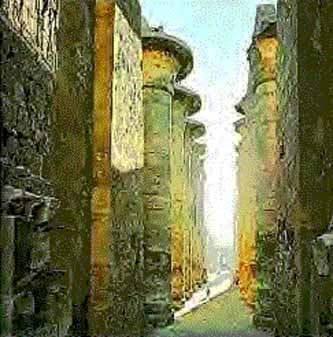
The Temple at Karnac is oriented toward
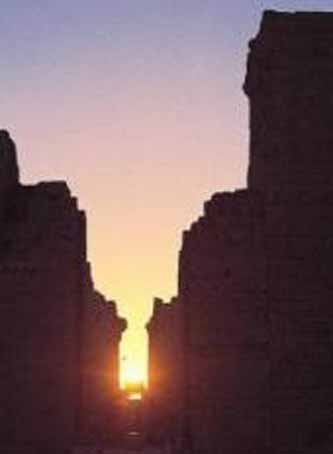
the sunrise of winter solstice.
It has been long recognized that the ancient Egyptians possessed a great knowledge of geometry,
mathematics and astronomy , all being the basis for the Great Pyramid of Giza which for 5000 years has stood as a monument to the great cultures that
once populated the Nile River Valley. One of the greatest achievements
of the Egyptians is the creation of a calendrical system which relied
heavily on lunar observations.
By 3000 B.C., they had devised a solar calendar of 365 days, the starting point of which hinged on the helical rising of Sirius, which also happened to coincide with the time of the summer solstice and the annual flooding of the Nile. While this all may seem to be rather unimpressive it
serves to solidify the intrinsic necessity for ancients to be in touch
with natural surroundings, through tracking celestial phenomenon, the
Ancient Egyptians were able to predict events of great significance in
their desert environment.There are other celestial observatories like it
in Egypt.
In the News ...
Sahara Astronomical Site Older Than Stonehenge - AP - April 1, 1998
Researchers have found a complex of slabs and stones in the Sahara
Desert that might be the oldest known monument built with astronomical
considerations in mind - far older than England's Stonehenge. It was
constructed by nomadic cattle-herders as much as 7,000 years ago in
southern Egypt, and probably was intended for rituals rather than
astronomical observations. An expert in ancient astronomy said that it
would be among the oldest astronomical monuments known, but that the
ages of such monuments are so uncertain it's impossible to know if the
Egyptian complex is the oldest. He also said the study presents
suggestive evidence, but not proof, for astronomical design.
The monument was discovered over several years of field work ending in
1997. Stonehenge was first used about 5,000 years ago and gained some of
its current stones about 4,000 years ago. The stones indicate the
points of midsummer sunrise and midwinter sunset, but nobody knows just
what people used Stonehenge for. The Egyptian stone complex, which isn't
circular like Stonehenge, is spread over an area 1.8 miles by
three-quarters of a mile. It includes 10 slabs some 9 feet high, 30
rock-lined ovals, nine burial sites for cows, each under a pile of 40 to
50 rocks weighing up to 200 or 300 pounds apiece, and a "calendar
circle" of stones. Many of these features line up in five radiating
lines, one of them running east-west.
The calendar circle is a 12-foot-wide arrangement of slabs about 18
inches long, most of them lying down. Two pairs of upright stones stand
directly across the circle from each other, defining a view that would
have displayed sunrise at the summer solstice, the researchers said.
That would be an important day to the cattle-herders, because summer is
when monsoon rains would begin. But the circle wouldn't have been a
very accurate indicator of when the solstice was occurring. It was "more
symbolic than practical. The circle also contains two other pairs of
standing stones that defined a north-south view. Charcoal from hearths
around the circle and wood from one of the burial sites date to about
7,000 years ago. It's not clear when most of the rest of the monument
was erected, but it was at least 5,000 years ago.
Peru
Towers point to ancient Sun cult
BBC - March 1, 2007

Pre-Inca Observatory Is Oldest in Americas, Study Says
National Geographic - March 1, 2007

Peruvian citadel is site of earliest ancient solar observatory in the Americas
PhysOrg - March 1, 2007
Fortified stone temple, ceremonial complex, at Chankillo is approximately 2,300 years old.
Machu Picchu - Intihuatana Stone - Hitching Post of the Sun
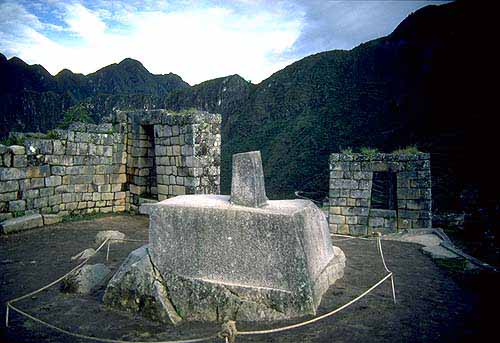
One of Machu Picchu's primary functions was that of astronomical
observatory. The Intihuatana stone (meaning 'Hitching Post of the Sun')
has been shown to be a precise indicator of the date of the two
equinoxes and other significant celestial periods. The Intihuatana (also
called the Saywa or Sukhanka stone) is designed to hitch the sun at the
two equinoxes, not at the solstice (as is stated in some tourist
literature and new-age books).
At midday on March 21st and September 21st, the sun stands almost
directly above the pillar, creating no shadow at all. At this precise
moment the sun "sits with all his might upon the pillar" and is for a
moment "tied" to the rock. At these periods, the Incas held ceremonies
at the stone in which they ³tied the sun² to halt its northward movement
in the sky. There is also an Intihuatana alignment with the December
solstice (the summer solstice of the southern hemisphere), when at
sunset the sun sinks behind Pumasillo (the Puma's claw), the most sacred
mountain of the western Vilcabamba range, but the shrine itself is
primarily equinoctial.
Shamanic legends say that when sensitive persons touch their foreheads
to the stone, the Intihuatana opens one's vision to the spirit world
(the author had such an experience, which is described in detail in
Chapter one of Places of Peace and Power, on the web site,
www.sacredsites.com). Intihuatana stones were the supremely sacred
objects of the Inca people and were systematically searched for and
destroyed by the Spaniards. When the Intihuatana stone was broken at an
Inca shrine, the Inca believed that the deities of the place died or
departed.
The Spaniards never found Machu Picchu, even though they suspected its
existence, thus the Intihuatana stone and its resident spirits remain in
their original position. The mountain top sanctuary fell into disuse
and was abandoned some forty years after the Spanish took Cuzco in 1533.
Supply lines linking the many Inca social centers were disrupted and
the great empire came to an end. The photograph shows the ruins of Machu
Picchu in the foreground with the sacred peak of Wayna Picchu towering
behind. Partway down the northern side of Wayna Picchu is the so-called
Temple of the Moon inside a cavern. As with the ruins of Machu Picchu,
there is no archaeological or iconographical evidence to substantiate
the new-age assumption that this cave was a goddess site.
Mesoamerica

As with other ancient cultures, observatories, pyramids and temples were
erected based on celestial alignments. Prior to the Maya rising to
power circa 400 AD in Central America and Mexico, there is evidence that
the Olmec people had
already begun to use astronomical orientations to direct the layout of
several ceremonial centers, with the Pyramids of the New World oriented
to observing and predicting the motions of the Sun and Mon.
As with the Egyptians, we can deduce that Mayan astronomical endeavors,
heavily relied upon the ritual and ceremonial worlds of the culture,
however, here we have a wealth of evidence to substantiate such claims.
Left behind are codices, or systems of hieroglyphic recordings of the
Maya, and which include celestial sightings and how these sightings and
predictions are woven into the entire cultural complex.
'The Dresden Codex' has perhaps proved the most fruitful in helping to
recreate the ancient environment, and containing an elaborate calendar
used to record the observations of Venus, which seems to be an object of
utmost importance to them. Working with both a solar calendar and a
ritual calendar, the ancient Maya imparted much meaning in the helical
rising of Venus, which is made evident in the structure of several
ceremonial centers throughout the area. Unlike the Megalithic and
Egyptian complexes, scientific observation can be better deciphered
here, because of the elaborate records left behind, and because of the
fact that so many of the deductions the Maya made so closely resemble
recent calculations of the same recorded cycles.
Like the Egyptians, the Maya had devised two calendars,
one solar and one ritual which interacted and depended upon one another
for the dictation of certain ritual events to be carried out. The sky
for the Maya was a seeming personification of Gods and deities who
played important roles in the daily lives of the population. Most
significantly, the relationship between the Sun and Venus (talked about
previously in the helical rising, conjunction, phases) was
representative of Kutaikcan, the God of Venus , and
"symbolizes the cyclic myth of departure and return or death and
resurrection." (Aveni 1984). In addition
other objects may have been tracked in order to predict certain
'natural' phenomenon in accordance to
seasonal changes therefor placing major importance on the accurate
predictions undertaken to better
predict the earthly events thought to be under the control of the Gods.
A great many structures are indicative of the devotion to and dependence upon Venus, to the Maya, and
can be found in the architecture ceremonial centers throughout the region. Caracol, at Chichen Itza sits
atop a large earthen mound and is a structure obviously intended for observing Venus at its most
extreme points on the horizon.
Just as famous, is the Governor's Palace at Uxmal, constructed so that
it would center on the helical rising of Venus at its southernmost point
during the eight year cycle it follows. Such an alignment can be
further substantiated by the fact that the Palace deviates from the
remainder of the buildings at Uxmal by twenty degrees, indicating the
care taken to insure the sight lines of the observation windows. The
careful planning inherent in the design and building of such structures
is made evident in the precision of their alignments, however this
precision was indispensable to the planning of ritual events and the
prediction of natural processes that so dictated the lives of the Maya.

In Chichen Itza, in Mexico there is a celestial observatory to the stars that was aligned along the line of the summer solstice and the winter soltice. It was built by the ancient Maya and their God Quetzalcoatl.

Observatory in the Chichen Itza complex
North America
Miami Circle
The Miami Circle, also known as The Miami River Circle or Brickell Point, is an
archaeological site in downtown Miami, Florida. It consists of a perfect
circle of 24 holes or basins cut into the limestone bedrock, on a
coastal spit of land, surrounded by a large number of other 'minor'
holes. It is the only known evidence of a permanent structure cut into
the bedrock in the United States, and considerably predates other known
permanent settlements on the East Coast. It is believed to have been the
location of a structure, built by the Tequesta (also Tekesta) Indians,
in what was possibly their capital. It was discovered in 1998, and is
believed to be somewhere between 1700 and 2000 years old, though some
have questioned both its age and its authenticity.

A strange circle formation has been discovered at the mouth of the Miami
River in what could be signs of an ancient culture. Archeologists have
discovered a perfect circle measuring 38 feet in diameter, with 24
irregular cut basins, ranging in size from one to three feet. Some
experts believe the basins depict the images of sea turtles, dolphins,
sharks, manatees, shrimp and other marine animals.
Centuries or millennia after its creation, the formation still seems
sacred because of its apparent function as a temple or astronomical
device. The structure has 41 potholes on each side of the circle's
center along the east-west axis. It measures the precise outlines of the
autumnal equinox (the time when the sun crosses the equator, making
night and day equal in duration) and the summer and winter solstices
(the northern and southern extremes of the sun's seasonal travel through
the sky).
Could it be that the time-obsessed Maya or maybe a much older culture
carved this astronomical observatory for future memory or to remind us
what was sacred to our ancient people?
Archeologists say the perfect circle measuring 37.5 feet in diameter,
with 24 irregular cut basins, ranging in size from one to three feet,
may have an "astronomical purpose" as it has an obvious east-west
alignment. Some experts believe the basins depict the images of sea
turtles, dolphins, sharks, manatees, shrimp and other marine animals.
Mainstream experts familiar with the Miami Circle say it may be an
astronomical observatory. But they also note it could have been the
foundation of a sacred temple with no connection to the stars. Also,
mainstream archaeologists do not share the notion of an ancient global
stone civilization linking the Egyptians, Incas or Mayans. In addition,
the standard view of ancient Egyptian history is that the pyramids were
royal tombs - not astronomical monuments.


Does this observatory resemble Avebury?
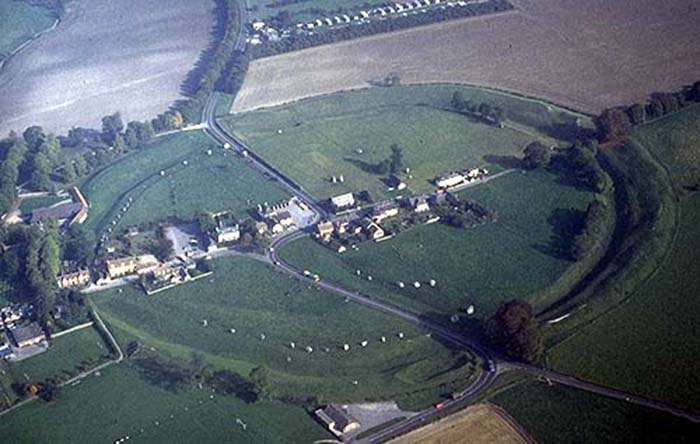
Or Stonehenge in England?

Stonehenge I (3100-2300 BCE)

Stonehenge IIIa (2100-2000 BCE)
Or ancient Mayan ruins?

Native American
Archaeoastronomy of North American Indians

The Native Americans called it Star Knowledge which included the ability
to mark events based on celestial alignments. Almost everything the
Lakota scholars brought together from elders in the Lakota Star Knowledge book is about observations leading to the summer solstice where the
sunpath will be at its farthest north, the days are longest, and the Sun
Dance is held "when the sun is strongest and the power of growing
things is greatest".
Chaco Canyon - Sun Dagger

Cahokia was the most important center for the peoples known today as
Mississippians. Their settlements ranged across what is now the Midwest,
Eastern, and Southeastern United States. Cahokia maintained trade links
with communities as far away as the Great Lakes to the north and the
Gulf Coast to the south. Pottery and stone tools in the Cahokian style
were found at the Silvernale site near Red Wing, Minnesota.
At the high point of its development, Cahokia was the largest urban
center north of the great Mesoamerican cities in Mexico. Although it was
home to only about 1,000 people before ca. 1050, its population grew
explosively after that date. Archaeologists estimate the city's
population at between 8,000 and 40,000 at its peak, with more people
living in outlying farming villages that supplied the main urban center.
If the highest population estimates are correct, Cahokia was larger than
any subsequent city in the United States until about 1800, when
Philadelphia's population grew beyond 40,000.
Fajata Butte in Chaco Canyon, New Mexico boasts a chamber in which a spiral petroglyph may be found. The glyph is surrounded by stone slabs allowing only
scant light to penetrate into the darkness, and as the sun makes its
appearance, a slit of light climbs the wall arriving at the center of
the petroglyph at noon at the time of equinox. A number of artistic
depictions of celestial phenomenon can be found as well, left behind by
various tribes, indicating that even if they were not predicting the
movements of the stare, they were intently contemplating the evident
motions of the celestial bodies which corresponded to their various
mythologies. This also marks a 19-year lunar cycle as the spiral has 19
rings.
Chaco Canyon was an important Anasazi cultural center from about 900 through 1130 AD. About 30 ancient
masonry buildings, containing hundreds of rooms each, attest to Chaco's
importance. Some structures are thought to serve as astronomical
observatories or calendars. At noon on the summer solstice, a dagger of
sun penetrates the center of the spiral. On the autumnal equinox, a sun
dagger passes through the center of a small spiral on the left, and
another passes on the edge of the large spiral. At the Winter Solstice, a
big sun dagger passes on either side of the large spiral.
Cahokia Mounds in southern Illinois near East St. Louis has a circle of
postholes interpreted in 1970 as an astronomical indicator of summer
solstice sunrise, winter solstice sunrise, and equinox sunrise. Monk's
Mound is the central focus of this great ceremonial center. A massive
structure with four terraces, it is the largest man-made earthen mound
in North America. Facing south, it is 92 feet (28 m) high, 951 feet (290
m) long and 836 feet (255 m) wide. The Travel Channel has called it the
"world's largest pyramid." Excavation on the top of Monk's Mound has
revealed evidence of a large building - perhaps a temple or the
residence of the paramount chief - that could be seen throughout the
city. This building was about 105 feet (32 m) long and 48 feet (15 m)
wide, and could have been as much as 50 feet (15 m) high. The east and
northwest sides of Monk's Mound were twice excavated in August 2007
during an attempt to avoid erosion.
Woodhenge

"Woodhenge," a circle of posts used to make astronomical sightings,
stood to the west of Monk's Mound. The name is taken from Stonehenge, as
this structure marked solstices, equinoxes and other astronomical
cycles. Archaeologists discovered Woodhenge during excavation of the
site. They found that the structure was rebuilt several times during the
urban center's roughly 300-year history. According to Chappell, "A
beaker found in a pit near the winter solstice post bore a circle and
cross symbol that for many Native Americans symbolizes the Earth and the
four cardinal directions. Radiating lines probably symbolized the sun,
as they have in countless other civilizations." It is not to be confused
with another site of the same name that exists in the United Kingdom.
Fascinating information about the people who once built the great
prehistoric city of Cahokia was revealed accidentally during excavations
in the early 1960s. Professional archaeologists were trying desperately
to save archaeological information which was to be destroyed by the
construction of an interstate highway, which was later rerouted. After a
summer of intense excavation, Dr. Warren Wittry was studying excavation
maps when he observed that numerous large oval-shaped pits seemed to be
arranged in arcs of circles. He theorized that posts set in these pits
lined up with the rising sun at certain times of the year, serving as a
calendar, which he called Woodhenge. More post pits were found where
predicted, and evidence that there were as many as five Woodhenges at
this location. These calendars had been built over a period of 200 years
(A.D. 900-1100). Fragments of wood remaining in some of the post pits
revealed red cedar had been used for the posts, a sacred wood.
The first circle, only partially excavated, (date unknown) would have
consisted of 24 posts: the second circle had 36 posts; the third circle
(A.D. 1000), The most completely excavated, had 48 posts; the fourth,
partially excavated, would have had 60 posts. The last Woodhenge was
only 12, or possible 13 posts, along the eastern sunrise arc(if it had
been a complete circle, it would have had 72 posts). Building only the
sunrise arc might indicate that red cedar trees had become scarce. It is
not known why the size and location of the circles, and the number of
posts was constantly changed - perhaps to include more festival dates or
to improve and increase alignments.
Only three posts are crucial as seasonal markers - those marking the
first days of winter and summer (the solstices), and the one halfway
between marking the first days of spring and fall (the equinoxes).
Viewing was from the center of the circle, and several circles had large
"observation posts" at that location, where it is likely the sunpriest
stood on a raised platform. Other posts between the solstice posts
probably marked special festival dates related to the agricultural
cycle. The remaining posts around the circle have no known function,
other than symbolically forming a circle and forming an enclosure to
hold the sacred Woodhenge ceremonies. There have been suggestions some
posts had alignments with certain bright stars or the moon, or were used
in predicting eclipses, and others have suggested Woodhenge was used as
an engineering "aligner" to determine mound placements, but none of
this has been proven convincingly.
The most spectacular sunrise occurs at the equinoxes, when the sun rises
due east. The post marking these sunrises aligns with the front of
Monks Mound, where the leader resided, and it looks as though Monks
Mound gives birth the sun. A possible offertory pit near the winter
solstice post suggests a fire was burned to warm the sun and encourage
it to return northward for another annual cycle and rebirth of the
earth. This probably marked the start of the new year.
The third circle (A.D. 1000) was reconstructed in 1985 at the original
location. The circle is 410 feet in diameter, had 48 posts spaced 26.8
feet apart (9 are missing on the west side, removed by a highway borrow
pit). The posts were 15-20 inches in diameter and stood about 20 feet
high. Red ocher pigment found in some of the post pits suggests the
posts may have been painted. The post pits averaged 7 feet long and just
over two feet wide, sloping from the surface at one end to a depth of
four feet at the other, forming a ramp to slide the posts down to
facilitate their raising.

The Big Horn Medicine Wheel in the Big Horn Mountains near Sheriden,
Wyoming was interpreted in 1974 as an indicator of summer solstice
sunrise and sunset, with other alignments for the rising of certain
stars (Aldebaran, Rigel, and Sirius).
Built about 1050 AD. Has 28 spokes, and is about 90 ft in diameter.
About 50 similar circles exist. The oldest is in Canada (built about
2500 BC - the age of the Egyptian pyramids, for comparison).
The alignments presented by these stone circles are controversial; they
could be due to chance. There is no evidence that they were astronomical
in design. Why were they interested in those 3 particular stars?
Research regarding North American Indian astronomical insight has just recently begun to gain headway in
the studies of archeoastronomers, and while the same volume of evidence does not exist as with
cultures such as the Maya, the depth of Native American astronomical use and understanding is beginning
to emerge. Based on the climactic conditions of more northern latitudes, it is safe to assume that one of
the major reasons various tribes tracked the stars was for the prediction of seasonal change, which
would indicate to nomadic or semi nomadic peoples that it was time to relocate for the winter months.
This idea can be tied to the alignments found by John Eddy in the remains of the Big Horn Medicine Wheel in Wyoming.
At Big Horn, Eddy noticed that by standing at the hub of the wheel one
is able to deduce "a coherent alignment scheme" where the points on the
outer wheel correspond to the sunrise of summer
solstice, as well as the rising of Rigel, Aldebran, and Sirius, all of
which have helical risings at the time of
year when the site was climactically suited for occupation.
Makeshift structures and artwork in the southern United States argue for the ingenuity of the various
architects responsible for constructing them, and as to the important part of astronomical phenomenon in
constructing their own cosmos. Von Del Chamberlain notes that even structures dedicated to habitation
may have served as observatories, and has found that the Pawnee earth lodges "highlight a number of
celestial phenomena, ranging from the movement of the solar disk to that of constellations known to have
been named".
While lack of written records stall progress somewhat, the strong mythological tradition that exists
among the descendants of various North American Indian groups helps in deciphering the origins of myth
that would lend explanation as to the importance of the sky in the life ways of native cultures. A certain
number of scholars however have raised the question as to whether North American Indian astronomy
can in fact be considered in the context of archeoastronomy and its study of prehistoric peoples,
contending that these Indian populations may have been tainted by Christian schools of thought
somewhere along the line. While this is a valid point, and deserves consideration, it is important to
account for the mythological elements which factor into the overall schematic.



